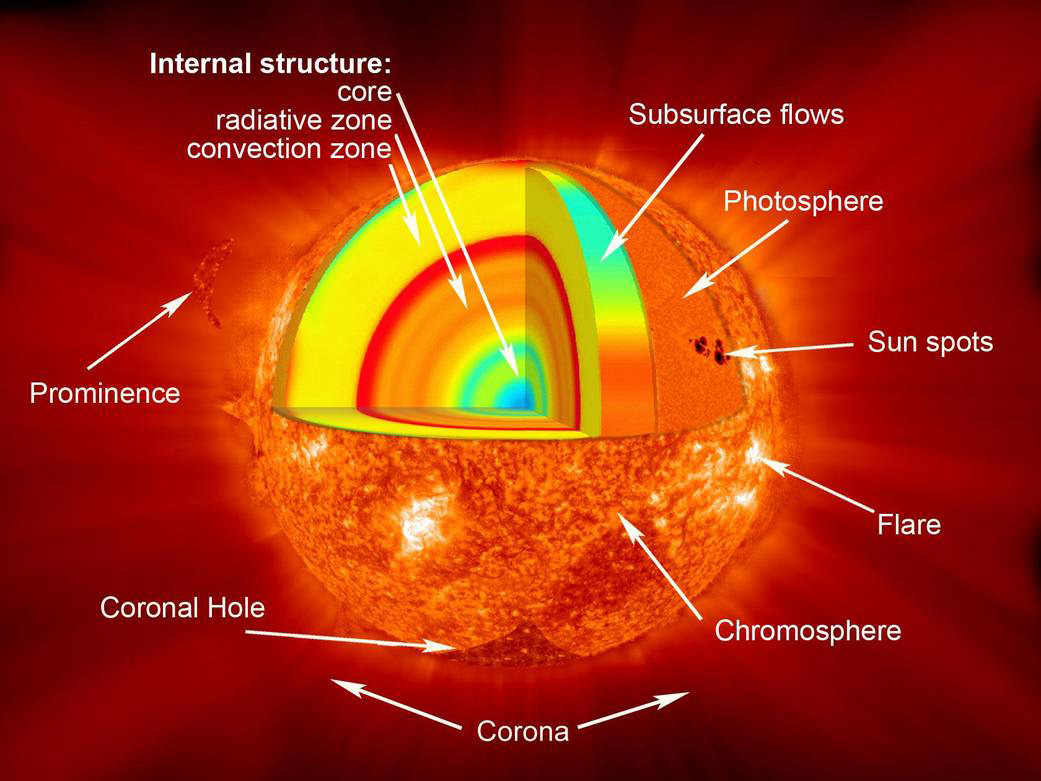Expanded from question three of the big three heliophysicist investigative questions: What causes the Sun to vary? Learn more ›
The Sun and its atmosphere consist of several zones or layers. From the inside out, the solar interior consists of: the Core, the Radiative Zone, the Convective Zone. The core is the central region where nuclear reactions consume hydrogen to form helium. These reactions release the energy that ultimately leaves the surface as visible light. The Radiative Zone extends outward from the outer edge of the core to the base of the convection zone, characterized by the method of energy transport - radiation. The Convection Zone is the outermost layer of the solar interior extending from a depth of about 200,000 km to the visible surface where its motion is seen as granules and supergranules. The solar atmosphere is made up of: the Photosphere (the visible surface of the Sun), the Chromosphere (an irregular layer above the photosphere where the temperature rises from 6000°C to about 20,000°C), a Transition Region (a thin and very irregular layer of the Sun's atmosphere that separates the hot corona from the much cooler chromosphere), and the Corona (the Sun's outer atmosphere).

Best Practice! Using Guiding Questions to Drive Inquiry
Each big idea has student-friendly questions written at different levels that you can use to guide inquiry-based investigations at the appropriate level. Explore this big idea at each level below, with featured resources you can engage learners with.
Introductory Learner
Guiding Question: How does the Sun's energy interact with each one of Earth's major systems (atmosphere, geosphere, biosphere, hydrosphere)?
Standards: PS3, ESS2, LS2
Heliophysics Narrative:
- Energy from the Sun interacts with all of Earth's major systems. Earth's atmosphere absorbs and reflects incoming solar radiation. The geosphere of the Earth is warmed by sunlight, and depending on the type of surface, reflects sunlight, for example ice reflects more sunlight than asphalt. The biosphere relies on the Sun for food as the energy travels through the food chain, and the hydrosphere (the water cycle) is driven by the energy from the Sun.
- At this level, students begin in grade K to make observations about how the sunlight warms different parts of Earth's surface (geosphere) (K-PS3-1,2) and by grade 2 they begin to explore how plants use light from the Sun to grow (biosphere) (2-LS2-1). At grade 4, students know that light is energy and explore how energy is transferred (4-PS3-2), and are able to identify Earth's major systems by grade 5 (ESS2-1.)
- Connect to the Sun by emphasizing that the Sun is central to all of Earth's systems and that none of Earth's systems would exist without the Sun. Emphasize that the atmosphere plays a critical role in protecting Earth from harmful radiation from the Sun, and also in insulating Earth and preventing heat loss out into space.
- Extend student exploration by telling students that it takes about 8 minutes for the light from the Sun to reach Earth (without getting too much into the speed of light). Have them articulate which Earth system the light reaches first, and challenge them to trace the path it takes through the other systems.
- Support beginner students by modeling how to safely make observations about the Sun and how it affects temperature.
- Challenge students at the next level by encouraging them to investigate how we can use the Sun's energy to create heat, using solar panels, for example.
Featured Resource: Meet ICON: NASA’s Airglow Explorer ›
Intermediate Learner
Guiding Question: How do solar panels work?
Standards: PS3, PS4, ESS2, ESS3
Heliophysics Narrative:
- Solar panels, most commonly made out of silicon, have a bunch of individual solar cells, or photovoltaic (PV) cells, which is a device that converts light energy into electrical energy. The dark silicon absorbs the photons, or particles from light, which the PV cells convert into electricity. Buildings with solar panels can store the energy in batteries for when it is nighttime or when it is cloudy. Instead of batteries, which can be expensive, many households will connect to the electrical grid, and the electric company buys the electricity created by the solar panels from the homeowner.
- At this level students are investigating how light travels (MS-PS4-2) and how energy is transferred, which includes how heat is transferred in different ways, through radiation, convection, and conduction (MS-PS3-3). They are also exploring how energy from the Sun flows through Earth's systems (MS-ESS2-1), the consequences that have occurred because of the way humans extract and consume energy resources on Earth (MS-ESS3-3), and the solutions needed to sustain Earth's resources (MS-ESS3-3).
- Connect to the Sun by tracing the path of a photon of light from the interior of the Sun (core), outward through the radiative zone and the convection zones of the Sun, all the way to the Sun's surface (photosphere), outward into space, eventually reaching Earth. The solar structure provides several examples for how thermal energy is transferred.
- Extend student exploration by having them research the efficiency of solar panels and to make a claim, using evidence and reasoning, as to why or why not solar cells panels are a good alternative to fossil fuels.
- Support beginner students by reviewing how light transfers energy from place to place (4-PS3-
- Challenge students at the next level by encouraging them to investigate how energy is created at the Sun’s core through nuclear fusion.
Featured Resource: Science Friday - Hack A Solar Circuit ›
Advanced Learner
Guiding Question: How does the Sun make energy?
Standards: PS1, PS3, ESS1
Heliophysics Narrative:
- The Sun makes energy through the fusion of hydrogen into helium at the Sun's core. Fusion creates a huge amount of energy, so much energy that we cannot successfully duplicate it on Earth for a sustained period of time. The energy travels through the radiative zone and the convective zones of the Sun, through other layers, all the way to the Sun's surface (photosphere), outward into space, eventually reaching Earth. The Sun will continue to make energy for another 5 billion years, when it will run out of hydrogen atoms to fuse.
- Students at this level are studying nuclear processes (HS-PS1-8), the processes that occur in the core of the Sun (HS-ESS1), and are able to quantify the law of conservation of energy (HS-PS3,4).
- Connection to the Sun is explicit in the NGSS. Emphasize to students that the Sun will continue to burn hydrogen at its core for billions of more years, as the forces in the Sun are balanced: the internal pressure created by nuclear fusion pushing outward and the external pressure of gravity pushing in on the star are in equilibrium. But when the amount of hydrogen becomes insufficient for nuclear fusion to create energy, there will no longer be enough internal pressure keeping the star from collapsing in on itself. Gravity takes over, compressing the core of the star, which then heats the interior of the star, causing it to expand. The Sun will expand into what is known as a red giant, most likely engulfing all of the inner planets, that would result, eventually, in the end of the solar system. As the red giant cools, the core of the star is left as a dim, cool object known as a white dwarf, which does not have enough energy to warm planets in orbit, if there were any.
- Expand student exploration by having them investigate the fusion that occurs in more massive stars. Many layers of fusion create more elements, up to iron, as iron requires more energy to fuse than it creates. When the core of the star reaches this critical iron-rich state, the core catastrophically collapses, resulting in a supernova explosion. Heavier elements than iron are created in these explosions, and are sent flying out into the universe in all directions, creating opportunities for the creation of new stars and planetary systems.
- Support beginner students by reviewing how energy is transferred (MS-PS3-3).
- Challenge students at the next level by having them investigate the Hertzspurng-Russell diagram and the different types of stars found in the universe.
Featured Resource: Activity: Fusion Reactions ›
What level are my learners?
Introductory: A younger learner (K-5), or a learner new to the subject matter.
Intermediate: A middle-aged learner (6-8), or a learner that has some familiarity with the subject matter.
Advanced: An older learner (9-12+), or a learner that has a lot of experience with the subject matter.
Note: Next Generation Science Standards (K-12) are mapped to the resources accordingly.
What is a NGSS Heliophysics Narrative?
NGSS Heliophysics Narratives support educators with the incorporation of heliophysics concepts and resources into their existing curricula. The narratives consist of relevant heliophysics background information, applicable NGSS performance expectations, and guiding questions to spark inquiry-based learning at the appropriate level.
Narrative Structure:
- Short answer to the question, for teacher background knowledge
- An analysis of NGSS Performance Expectations (PE) to determine learning constraints at each level
- Heliophysics topics that connect to the NGSS PE and can be infused into teaching systems science
- More heliophysics to explore
- How to support beginner learners
- How to challenge learners at the next level





